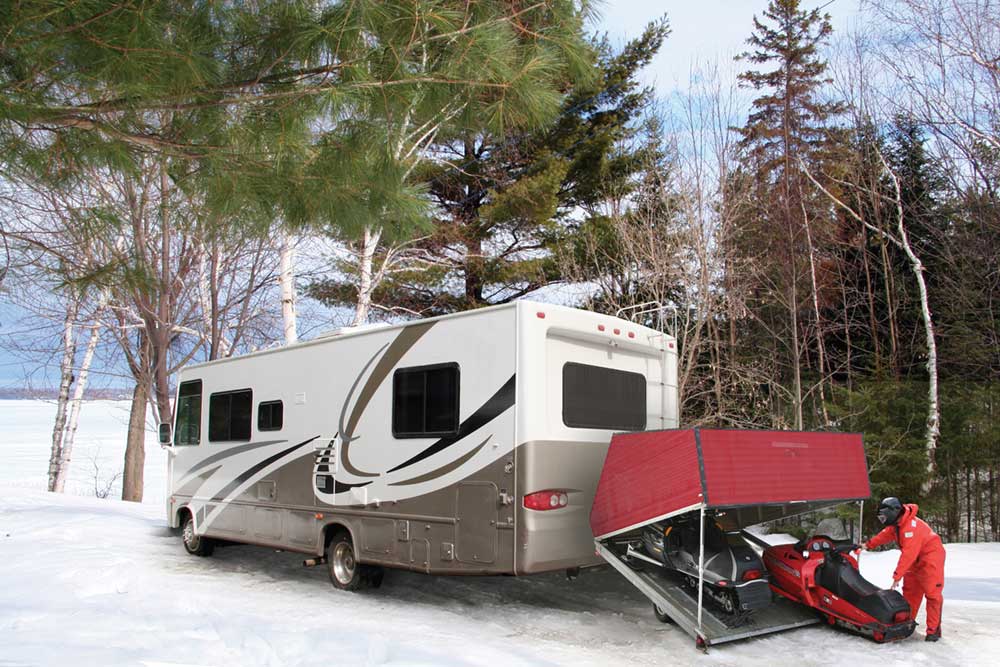Winter is fast approaching and many RV parks and campgrounds are closing for the season. But winter can still be a wonderful time to be an RVer! Whether you’re going south for the winter or hoping to hit the snowy slopes, here are some tips to help you make the most of winter RVing. Use these tips for how to winterize an RV.
Steps for How to Winterize an RV
Anticipate Freezing
Even those who head south for winter will need to be prepared for the possibility of freezing temperatures. Keeping your water in liquid form is perhaps the single most challenging and most important task for winter RVers (for those not “boondocking,” or dry camping in Wisconsin). There are many ways to insulate your water hoses and tanks in the winter, and most are not difficult to successfully implement. Consider running a heated cable or “heat tape” along your water hose and then wrapping it in additional insulation.

Water intake points—spigots/pumps—should be insulated as well. You may even want to fill your fresh water tank ahead of time, while you’re sure you have access to liquid water. As for sewer water, the best way to ensure that doesn’t freeze is to make sure it will continuously flow downhill; if you can’t pick a spot with a natural downhill slope, then a sewer hose support can help. If worse comes to worst and your hoses freeze solid, a hair dryer can help thaw them in a pinch.
Prevent Heat Loss
Your water isn’t the only thing that needs to keep warm. Insulating your whole RV can make a huge difference to your comfort and to your fuel and electric costs. An RV skirt can help insulate and weatherproof your RV, while insulating windows with plastic will eliminate a significant heat loss culprit. Some DIYers even recommend using spray foam to insulate water tanks and basement storage areas—just be sure not to spray foam over any handles, latches, or anything else that may need to be moved or accessed later.
Supplement Your Furnace
Winter RVing means you’ll be getting a lot of use out of your RV’s furnace. But for some, relying too heavily on your furnace can mean prohibitively high propane costs. Cut down on propane costs by investing in a couple electric space heaters for your most trafficked spaces. Even a propane space heater will sip propane compared to your furnace. Just be smart: whenever using propane heaters, make sure you have a working carbon monoxide detector nearby. While you’re at it, warm linens and an electric blanket or mattress pad can help you avoid overusing your furnace during those cold winter nights.
Control Condensation
When it’s cold outside, water is quick to condense out of the air, which makes for dry sinuses and wet RV surfaces. Moisture can quickly become a nuisance in RVs, leading to potential mold, mildew, and unpleasant musty smells. Control moisture buildup by squeegeeing bathroom fixtures and windows, or wiping them dry with a shammy. Some electric space heaters will also help dry out the air before water has a chance to condense, but you may also want to invest in a good dehumidifier (this has the added benefit of being a small water source if your hoses freeze, though you should never drink dehumidifier water).
Because closets, cabinets, and drawers often remain closed for long periods of time, these are at higher risk of collecting moisture and forming mold; combat this by periodically opening these spaces and allowing air to circulate. This has the added benefit of allowing warmed air to reach pipes that may run through or behind these spaces.
If you are sensitive to dry winter air, you may want to avoid using a humidifier in your RV. Instead, combat the dry air simply by drinking water often—this keeps your sinuses and skin from getting uncomfortably dry.
Location, Location, Location
Picking a good RV spot can make a big difference to your daily efforts to keep things warm. If you have a choice of spots, try to pick one that will allow the sun to shine on your RV for a good portion of the day, but also has trees or other structures to help protect your RV from cold winter winds. If you can, always park your RV so that the sides of the RV are out of the wind as much as possible, especially if you aren’t using an RV skirt.



